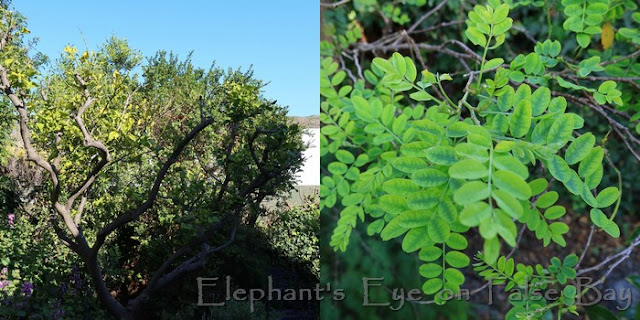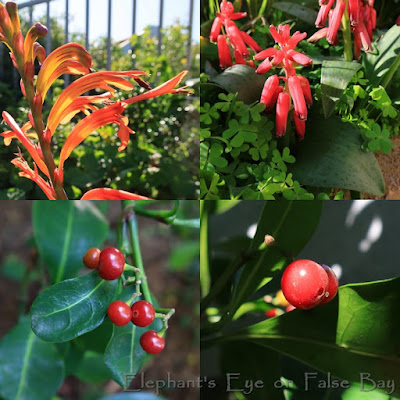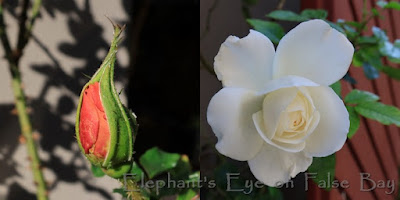False Bay garden in June
by Diana Studer
- gardening for biodiversity
in Cape Town, South Africa
The spekboom is taller that the giraffe. When I planted the cutting in March 2018 the giraffe was the tall looking down his nose one.
 |
| Giraffe watching the spekboom grow |
Still on a mission to prune and tidy the neglected plants after the wall was raised. Took a substantial chunk off the Searsia crenata behind the lemon tree. When it has recovered, will take off the next tall slice. Also making space for Indigofera jucunda against the wall (somewhat battered when the ivy 'wall' was towed away!)
 |
| Rescuing the lemon tree and Indigofera |
What has stripped all the leaves off the Senecio tamoides which was meant to screen a rain tank? From iNaturalist tiger moth caterpillars.
 |
| Tiger moth caterpillars |
In the tapestry hedge gap Halleria lucida, planted 2 years ago, has achieved hedge height. Maurocenia frangula with shiny cherry red new leaves is filling in slowly. Each end of the hedge is anchored by bietou with intense yellow daisy flowers.
 |
| In the tapestry hedge |
Metalasia muricata has faded and sheds grey seeds. Pruning carefully around the cocktail ants carton nest
 |
| Ants carton nest |
Olea is about twice as tall as I think it is, when seen thru the bay window. And behind it Brachylaena discolor again towers over our neighbour's garage - cut cut cut. Trimming back carefully to lighten for Kumara plicatilis (didn't expect this supposedly sunny and open part of our garden to close in so much!)
 |
| Olea left and Kumara tucked in the far right |
Aloe marlothii blooms bravely to the left but needs more space. To the right Aloe ferox has buds, some space, but needs the hedge topped for more sun.
 |
| Aloes need rescuing |
Glowing in reds. Orange Chasmanthe bulbs. Smaller but just as vigorous red Lachenalia bulbs. Psychotria capensis has red berries for our birds.
 |
| June flowers and berries in red |
June roses. Tight bud on South Africa and always Icebergs. Suiting this grey chilly day with rain bucketing down this morning, after yesterday's feverish berg wind. You want weather? We have it.
 |
| June roses |
I am using a small card (instead of my fingers) to convince the camera to see What I See, thank you. Pattern on Hypoestes aristata standard. Topknot on French Lavandula dentata. Happiness is blue Felicia. Cotyledon orbiculata with glaucous grey leaves and muted orange flowers.
 |
| June flowers in blues |
Come. Through the Garden Gate, Down by the Sea with Sarah in Dorset.
I invite you to join us at Elephant's Eye on False Bay. Please subscribe as you prefer
via Feedly,
or my Facebook blog page
Pictures by Diana Studer
of Elephant's Eye on False Bay
Teal blue text is my links.
To read comments if you are in a Reader,
first click thru to the blog)
Thanks for comments that add value. Your comment will not appear until I've read it. I welcome comments on posts from the last 2 months.
Google and Blogger comments uncooperative? Use Name / URL instead.

Pruning is a seemingly endless chore but worth the effort. Your cocktail ants sound as awful as the imported fire ants we have here - I hope you manage to stay clear of them. I'm still recovering from my last encounter with fire ants on my back slope.
ReplyDeleteWe have a good working relationship. That nest built of plant fibre is fascinating to look at, and easy to avoid. (They do bite, but not nasty like your fire ants!)
DeleteAll sorts of good things going on in your garden--and hooray for rain! I'm shortening some shrubs myself--it does take time and effort. 'Iceberg' always, here, too. :)
ReplyDeleteOn these grey days it is more urgent to let the winter sun reach the plants that need it.
DeleteIt was fun to see a bit of a wider view of your lovely garden. I have to remind myself that it’s winter there now, but certainly not the kind of winter that I know! I’m not familiar with cocktail ants, and I don’t think I want to know. Ohio USA ants don’t bite much, but they do love to be in my kitchen, where they are not welcome.
ReplyDeleteThey are polite little ants. Keep your social distance. If you come too close they cock their tails in warning. Your fault if you ignore the warning and they bite you. The nest is obvious - like papier mache halfway up a shrub. Garden, not house, residents.
DeleteI'm always amazed by the amount of colour in your garden, even in mid winter! As lavender is a spring/summer flowering plant in the Mediterranean, how come yours is flowering now, with your mild Mediterranean climate?
ReplyDeleteLovely selection and interesting to hear about the jobs you are doing.
My lavender seems to flower year round, something to feed bees.
DeleteIt's always fun for me to see what you have in bloom, and I love your giraffe. I was interested to see your tiger moth caterpillars, which seem to be cousins of a caterpillar in my garden called milkweed tussock moths or sometimes milkweed tiger moths. If yours are like mine, the egg hatches large groups of caterpillars, which at least in their early instars, engage in congregate feeding. They can strip a plant bare of foliage in the blink of an eye.
ReplyDelete